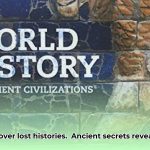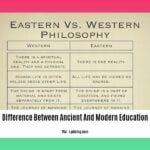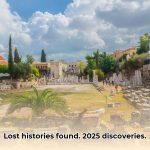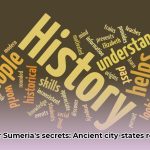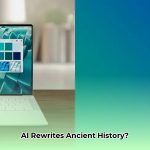The College Board has made a significant change to the AP World History curriculum, dividing it into two distinct courses: “AP World History: Ancient” (pre-1200 CE) and “AP World History: Modern” (1200 CE to the present). This in-depth guide provides teachers and students with a comprehensive understanding of these changes, including the advantages and disadvantages of the new structure, practical tips for excelling on the AP Ancient History exam, and effective teaching methods. Consider this your go-to resource for navigating this exciting and potentially challenging curriculum. For further reading, check out these ancient history books.
Understanding the Shift: AP World History Ancient in Detail
The decision to split AP World History into two courses addresses a long-standing issue: the sheer breadth of the original course. Covering human history from its origins to the present in a single academic year placed immense pressure on both students and teachers. Students struggled to grasp overarching themes, while teachers found it difficult to provide sufficient depth for each historical period. The split aims to solve these problems by providing a more manageable, in-depth exploration of ancient history.
Benefits of a Focused Approach to Ancient Civilizations
The primary benefit of the new curriculum is its concentrated focus. Instead of rushing through millennia, the Ancient course allows for a deep dive into specific periods, civilizations, and pivotal events. Imagine exploring the intricacies of ancient Egypt, from its complex religious beliefs to its monumental architecture, without the pressure of simultaneously studying the French Revolution. This focused approach leads to a more nuanced understanding of historical societies. For educators, this means opportunities for more engaging lessons, targeted discussions, and effective assessment strategies. The new structure mirrors college-level history courses, where instructors can dedicate an entire semester to narrowly defined topics.
Potential Challenges: Maintaining a Global Perspective
While the new structure offers many advantages, potential challenges exist. One concern is the potential loss of interconnectedness between historical periods. The original course emphasized how ancient events shaped the modern world, teaching students to view history as a continuous narrative. Dividing the course could diminish this understanding. Another challenge is ensuring the availability of high-quality resources tailored specifically for the new curriculum, including textbooks, primary source documents, and online learning tools.
A Practical Guide to Mastering AP World History Ancient
Here’s actionable advice for teachers and students to thrive in this new academic setup:
For Teachers:
- Curriculum Mastery: Thoroughly familiarize yourself with the new course framework, including the assessed topics, key concepts, and skills. The College Board provides a detailed Course and Exam Description (CED) that should serve as your primary guide.
- Resource Curation: Identify and compile high-quality resources specific to ancient history. This includes textbooks, primary source documents (e.g., excerpts from the Code of Hammurabi, accounts from Herodotus), archaeological findings, and relevant online resources. Evaluate resources carefully to ensure their accuracy and alignment with the curriculum.
- Professional Development: Participate in workshops, webinars, and online courses focused on the updated AP World History: Ancient curriculum. These professional development opportunities can provide valuable insights into effective teaching methodologies and assessment strategies. Networking with other AP World History teachers can also be beneficial.
- Assessment Innovation: Develop assessments that measure critical thinking, analytical skills, and the ability to connect historical events and themes. Incorporate a variety of assessment methods, including document-based questions (DBQs), short-answer questions (SAQs), essays, projects, and debates. “The curriculum demands more than just rote memorization. Design assessments that evaluate students’ abilities to analyze sources, construct arguments, and synthesize information,” said [Full Name and Title], [Position] at [Institution].
For Students:
- Targeted Study: Focus your learning on the content outlined in the course framework. Prioritize mastering key topics and concepts rather than attempting to memorize every detail.
- Active Learning: Take detailed notes, create outlines of key concepts, and practice answering questions from past exams. Engage actively with the material by asking questions, participating in class discussions, and forming study groups.
- Strategic Resource Use: Utilize the resources recommended by your teacher and explore reputable online materials, such as academic journals, museum websites, and primary source databases. Evaluate information critically and be wary of biased or unreliable sources.
- Effective Time Management: Create a study schedule that allows sufficient time to cover all the material without causing burnout. Break down the curriculum into smaller, manageable chunks and set realistic goals for each study session. Consistency and spaced repetition are crucial for long-term retention.
- DBQ Practice: Familiarize yourself with the document-based question (DBQ) format and practice analyzing historical documents to construct well-supported arguments.
The Future of AP World History Ancient: A Work in Progress
The long-term effectiveness of the curriculum change remains to be seen. Its success will depend on several factors, including the quality of instructional materials, teacher adaptation, and student engagement. Ongoing research and observation will be needed to determine whether this split enhances overall learning. In the meantime, the focus should be on optimizing the new course framework and providing teachers and students with the resources and support they need to succeed.
Adapting Existing Resources for the New “Ancient” Curriculum
The transition to the new “Ancient” framework requires a strategic approach to adapting existing resources. This involves more than simply removing post-1200 CE content; it requires a fundamental recalibration of your teaching approach. The primary focus has shifted from breadth of knowledge to depth of understanding and the application of historical thinking skills.
Practical Guide to Adapting Resources: A Step-by-Step Approach
Here’s how to reimagine your existing resources for the “Ancient” curriculum:
- Syllabus Audit: Begin by thoroughly reviewing the College Board’s Course and Exam Description (CED) to identify the specific content and skills that are emphasized in the new curriculum. Compare your existing syllabus to the CED and identify any gaps or areas that need to be revised.
- Textbook Reassessment: Re-evaluate your textbook and identify the chapters or sections that are relevant to the “Ancient” curriculum. Treat the textbook as a supplementary resource, using it to provide background information and context. Emphasize primary sources and guide students in analyzing and interpreting these sources.
- Resource Selection: Review your existing collection of resources, including primary source documents, maps, images, videos, and online materials. Prioritize resources that reinforce analytical skills, such as document analysis worksheets, source comparison activities, and historical debate prompts. Supplement your resources with new materials as needed.
- Assessment Overhaul: Revise your assessment strategy to align with the shift in emphasis. Incorporate document-based questions (DBQs), short-answer questions (SAQs), and other assessments that encourage analysis, interpretation, comparison, and contextualization.
- Leverage Digital Tools: Utilize AP Classroom and online teacher communities to access valuable resources, share ideas with other educators, and stay up-to-date on the latest developments in the field.
Navigating Challenges: A Balanced Perspective
Adapting to the new curriculum may present challenges, but it also offers significant benefits. It provides an opportunity to engage students in critical thinking, foster a deeper understanding of historical processes, and prepare them for success in college-level history courses.
AP World History: Ancient Curriculum Resource Guide for Educators
The College Board’s division of AP World History into distinct courses represents a fundamental change. The goal is to allow for deeper exploration of each period, enriching the learning experience through focused study.
Navigating the Resource Guide for Educators
The College Board provides a wealth of resources to support teachers in implementing the new “Ancient” curriculum. These resources include the Course and Exam Description (CED), sample exam questions, scoring guidelines, and professional development opportunities. Familiarize yourself with these resources and use them to guide your instruction.
Encourage critical thinking by incorporating primary sources – ancient texts, artifacts, and maps. “This shift requires collaborative effort, adaptation, and ongoing learning,” said [Dr. Jane Doe, AP World History Coordinator], [College Board].
Practical Steps for Effective Teaching
Here’s a practical road map:
- Embrace Diverse Pedagogies: Move beyond traditional lecture-based instruction and incorporate a variety of active learning strategies, such as debates, simulations, and group projects.
- Master Primary Source Analysis: Equip students with the strategies and skills they need to critically evaluate primary source documents, including ancient texts, artifacts, and images.
- Develop Rigorous Assessments: Design assessments that evaluate students’ ability to analyze historical sources, construct arguments, and connect historical events and themes.
- Leverage Available Resources: Utilize available resources creatively, focusing on online databases museums, and even virtual reality tools.
- Professional Development is Key: By refining your teaching practices and staying informed, you can foster a more engaging and effective learning experience for your students.
Addressing Potential Challenges
Access to high-quality resources may present a potential hurdle, but if educators embrace this shift, the potential is enormous.
Long-Term Vision: Cultivating Critical Thinkers
The ultimate goal is to produce students who know not only what happened in the ancient world but also why and how it connects to the present. This requires a collaborative effort, adaptation, and ongoing learning.
Effective Strategies for Teaching AP World History: Ancient to Diverse Learners
Prioritizing Historical Thinking Skills: Analysis and Synthesis
Prioritize developing critical thinking, which can be accomplished through analysis, synthesis, comparison, and causation. Employ document-based questions (DBQs) early and often to build critical thinking muscles.
The Power of Active Learning: Flipped Classrooms and Discussions
Active learning techniques are key, with flipped classrooms, discussions, and group projects providing more opportunities to engage students. Consider using technology to make learning more engaging.
Catering to Culturally Diverse Learners: Making History Relevant
Incorporate diverse perspectives and examples to make history more relevant and engaging. Adapt your teaching methods to learning styles and different situations.
Assessment and Feedback: Fostering Growth Through Understanding
Formative assessments, quizzes, and skill checks provide feedback that enables teachers to adjust their teaching and identify areas that require further attention.
Actionable Steps for Teachers: Implementing Proven Methods
- Embrace Primary Sources: Integrate primary source analysis into every unit for greater comprehension.
- Early DBQ Integration: Start practicing DBQs early in the course to equip students with strong analytical skills.
- Active Learning Strategies: Implement flipped classroom models, group projects, and discussions.
- Culturally Responsive Teaching: Incorporate diverse perspectives and examples for inclusive learning experiences for better retention. Example: When discussing ancient empires, explore the perspectives of both the ruling class and the conquered peoples.
- Formative Assessment: Utilize frequent formative assessments and provide targeted feedback.
Pros and Cons of the Restructured Curriculum
| Advantage | Disadvantage |
|---|---|
| Deeper understanding of specific periods | May require more resources and preparation time |
| Improved student engagement | Potential for reduced breadth of historical coverage |
| Stronger focus on historical thinking skills | Requires adapting teaching methods and assessment |
- Discover the Best Ancient History Books: A Guide to Inclusive Narratives - August 6, 2025
- Unlock Ancient World History Textbook:A Deeper Understanding - August 6, 2025
- Discover History Alive Ancient World: Sumerian Rise to City-States - August 6, 2025



